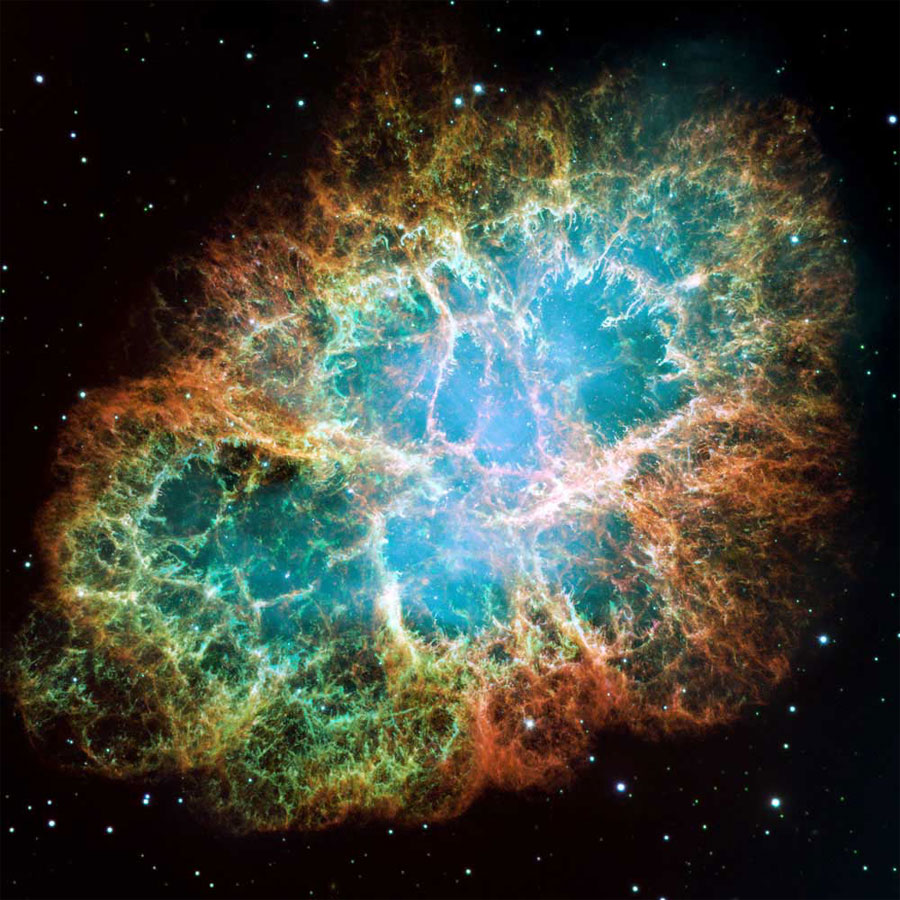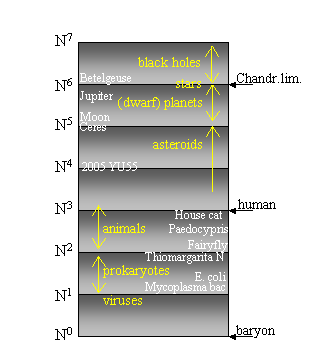 Probably most of us would prefer our neighboring stars to delay any of the supernova firework displays they might have in stock. In case the mere thought gets you worried: you should realize that we thank our very existence to supernovas. The heavier elements (in particular any atoms heavier than oxygen) which are essential for life to emerge, were absent in the early universe. It is due to the numerous supernova explosions that these elements got distributed across the cosmos. Supernovas have literally placed the seeds for all life in the universe, including that of ours. In doing so, the same supernovas might have destroyed earlier lifeforms on other planets. And if ultimately a supernova will end humanity,* it will at the same time place countlessly many seeds for new life. A reassuring thought, isn't it?
Probably most of us would prefer our neighboring stars to delay any of the supernova firework displays they might have in stock. In case the mere thought gets you worried: you should realize that we thank our very existence to supernovas. The heavier elements (in particular any atoms heavier than oxygen) which are essential for life to emerge, were absent in the early universe. It is due to the numerous supernova explosions that these elements got distributed across the cosmos. Supernovas have literally placed the seeds for all life in the universe, including that of ours. In doing so, the same supernovas might have destroyed earlier lifeforms on other planets. And if ultimately a supernova will end humanity,* it will at the same time place countlessly many seeds for new life. A reassuring thought, isn't it?
Strangely enough, life seems connected to supernovas in another, much more enigmatic way. I am talking here about the size of lifeforms seemingly being connected to the size of stars and supernovas. What follows are my own observations on this. Observations popping up in the mind of a physicist spending a late afternoon in his hammock. A physicist whose thoughts are in no way hampered by any deep understanding of biology.
With this disclaimer, let me share with you some unexpected 'connections' that relate the size of lifeforms to the size of stars and supernovas. Many of you might prefer the word 'coincidences' over 'connections'. And indeed, my present thinking is that some (if not all) of the surprising regularities that I will present might very well be pure coincidences. Yet, I feel compelled to share these regularities with you. Who knows, maybe there is an underlying deeper reason for them to come out the way they do. And maybe a reader more clever than me might get inspired by these regularities to follow thoughts that will open new directions in our understanding of the enigma called life.

Ladder of life. All of this will become clear in a minute!
Ladder Of Life
 What is life? In the 70 years since Erwin Schrodinger wrote a booklet with this title, many deep new insight has been gained in the areas of microbiology and biochemistry. Yet, we still have no clue how life manages to be emergent from the fundamental laws of physics.** What we do know for fact is that for life to manifests itself, organisms require a certain degree of complexity. Let's see if we can quantify this degree of complexity for different lifeforms.
What is life? In the 70 years since Erwin Schrodinger wrote a booklet with this title, many deep new insight has been gained in the areas of microbiology and biochemistry. Yet, we still have no clue how life manages to be emergent from the fundamental laws of physics.** What we do know for fact is that for life to manifests itself, organisms require a certain degree of complexity. Let's see if we can quantify this degree of complexity for different lifeforms.
All objects we are familiar with, including living beings, are clouds of baryons. Non-baryonic components (electrons and the like) hardly weigh in: 99.9 % of the mass surrounding us comes from just the two familiar baryons: protons and neutrons. These baryons have a tiny mass of 1.67 yoctogram (1.67 X 10-27 kg). Atoms typically consists of a few up to many tens of baryons. Molecules easily contain tens to thousands of baryons. And real large molecules even more.
How many baryons do we need at a minimum for life to emerge?
We don't expect an atom or a simple molecule to come to life. On the other hand, we know that 5 X 1028 baryons (the number of baryons in a typical human body) can support life. Somewhere in-between there must be a 'threshold for life'. But that doesn't mean we should expect a sharp answer of the form "for life to be viable you need X baryons, X-1 baryons is insufficient". Rather we should expect a rough order of magnitude estimate: "Objects as small as 10X baryons are known to be able to live, no life forms consisting of 10X-1 have ever been detected". And if life is emergent from the fundamental laws of physics, the threshold number 10X should be related to fundamental physical constants.
 At the bottom of the 'ladder of life' we find viruses. Viruses are often described as "organisms at the edge of life". With the very largest viruses such as the vaccine virus weighing in at around 6 X 10-18 kg, we can equate this 'edge of life' to structures containing roughly 3.6 billion (= 6 X 10-18/1.67 X 10-27) baryons. That is our magical number. The threshold of life. Half the world population. Three-point-six billion. Remember this number, you will see it coming back quite a few more times in this post, and in the end we will link this number to a fundamental physics constant.
At the bottom of the 'ladder of life' we find viruses. Viruses are often described as "organisms at the edge of life". With the very largest viruses such as the vaccine virus weighing in at around 6 X 10-18 kg, we can equate this 'edge of life' to structures containing roughly 3.6 billion (= 6 X 10-18/1.67 X 10-27) baryons. That is our magical number. The threshold of life. Half the world population. Three-point-six billion. Remember this number, you will see it coming back quite a few more times in this post, and in the end we will link this number to a fundamental physics constant.
 The most basic organisms that, in contrast to viruses, are undeniably alive are the prokaryotes. This is the realm of the bacteria. The smallest prokaryotes are the mycoplasma bacteria. This life form has a weight similar to that of the largest viruses, and therefore consist of a number of baryons roughly equal to the magical number 3.6 billion. This just confirms this number indeed describes the 'threshold for life'. But bacteria come in many different sizes. For instance, the E. coli bacterium is well over a hundred times more massive than the mycoplasma bacteria and consists of 6 X1011 baryons. Even more massive are bacteria like Thiomargarita namibiensis. This proteobacterium is a true heavyweight under the prokaryotes with a weight close to 3 X10-9 kg. A whopping 2 X 1018 baryons.
The most basic organisms that, in contrast to viruses, are undeniably alive are the prokaryotes. This is the realm of the bacteria. The smallest prokaryotes are the mycoplasma bacteria. This life form has a weight similar to that of the largest viruses, and therefore consist of a number of baryons roughly equal to the magical number 3.6 billion. This just confirms this number indeed describes the 'threshold for life'. But bacteria come in many different sizes. For instance, the E. coli bacterium is well over a hundred times more massive than the mycoplasma bacteria and consists of 6 X1011 baryons. Even more massive are bacteria like Thiomargarita namibiensis. This proteobacterium is a true heavyweight under the prokaryotes with a weight close to 3 X10-9 kg. A whopping 2 X 1018 baryons.
 When further increasing sizes, we reach the next step of our ladder of life: the eukaryotes. Within this diverse group we find protists, fungi, plants and animals. Here we focus on the animal eukaryotes, and in particular the smaller ones. Some Googling for "smallest animals" will direct you to exceptionally small animals, the fairyflies. These insects typically fit well within a millimeter and can be estimated to consist of close to 1019 baryons. That puts the smallest animal life form at a number of baryons not too far off from 3.6 billion squared. A pattern seems to develop, with the baryon count threshold for the most basic life forms being of the order of the magical number, and the threshold for animal life being close to the square of that number.
When further increasing sizes, we reach the next step of our ladder of life: the eukaryotes. Within this diverse group we find protists, fungi, plants and animals. Here we focus on the animal eukaryotes, and in particular the smaller ones. Some Googling for "smallest animals" will direct you to exceptionally small animals, the fairyflies. These insects typically fit well within a millimeter and can be estimated to consist of close to 1019 baryons. That puts the smallest animal life form at a number of baryons not too far off from 3.6 billion squared. A pattern seems to develop, with the baryon count threshold for the most basic life forms being of the order of the magical number, and the threshold for animal life being close to the square of that number.
 The well-known fruit fly is significantly heavier than the fairyfly and contains some 2 X1020 baryons. The next steps up are the mosquito (1.5 X 1021 baryons) and the house fly (1 X 1022 baryons). Similar in size to the house fly are the smallest vertebrates, miniature fish called Paedocypris progenetica and the Schindleria brevipinguis. Going up in size we enter the domain of the mammals. We come across mice (2 X 1025 baryons) and house cats (3 X 1027 baryons), and finally arrive at the most advanced of all animal eukaryotes: humans. When fully grown, these creatures consist of about 5 X 1028 baryons. You might have guessed it: this is our magical number 3.6 billion to the third power.
The well-known fruit fly is significantly heavier than the fairyfly and contains some 2 X1020 baryons. The next steps up are the mosquito (1.5 X 1021 baryons) and the house fly (1 X 1022 baryons). Similar in size to the house fly are the smallest vertebrates, miniature fish called Paedocypris progenetica and the Schindleria brevipinguis. Going up in size we enter the domain of the mammals. We come across mice (2 X 1025 baryons) and house cats (3 X 1027 baryons), and finally arrive at the most advanced of all animal eukaryotes: humans. When fully grown, these creatures consist of about 5 X 1028 baryons. You might have guessed it: this is our magical number 3.6 billion to the third power.
Time to summarize what we found. Have a look at the lower half of the graphical display at the top of this blog post. It ranks structures and organisms of increasingly larger size. The vertical axis measures these sizes in numbers of baryons expressed in powers of the magical number N = 3.6 billion. At zeroth power we find a single baryon. Going up in size we encounter atoms, molecules and proteins. At power one we witness the boundary between viruses and prokaryotes: the threshold for the most elementary form of life to be viable. The range from power one to power two is the realm of the prokaryotes: bacteria of widely different sizes occupy this range. Eukaryotic animal life starts at power two and reaches its pinnacle in intelligent life at power three.
Hokus pokus? Ok, let's see if we can make a connection with physics.
From Asteroids to Supernovas
 Fast forward to the fifth power of our magical number. Objects consisting of this number of baryons are huge in size. We have entered the realm of astronomy. Power five marks the transition between asteroids and dwarf planets. It is the size at which gravity becomes powerful enough to mold the object spherical in shape. Going up in size we encounter planets of increasingly larger sizes, and finally at power six we hit upon stars.
Fast forward to the fifth power of our magical number. Objects consisting of this number of baryons are huge in size. We have entered the realm of astronomy. Power five marks the transition between asteroids and dwarf planets. It is the size at which gravity becomes powerful enough to mold the object spherical in shape. Going up in size we encounter planets of increasingly larger sizes, and finally at power six we hit upon stars.
Now this gives us a clue about the physics behind the magical number N. The size at which lumps of matter form stars is the size at which gravity becomes a truly dominant force. As it happens, star sizes straddle a limiting size for gravity induced collapse named the Chandrasekhar limit, after its discoverer the Indian-American astrophysicist Subrahmanyan Chandrasekhar. Stated in its most basic form, the Chandrasekhar limit tells us that an object with a number of baryons exceeding the cube of the ratio between the Planck mass to the baryon mass is gravitationally unstable and bound to collapse. This collapse can be delayed by igniting thermonuclear reactions that create radiation pressure strong enough to prevent the object to collapse. Such radiating objects we refer to as stars. However, once the thermonuclear fuel gets exhausted, the radiation pressure drops and a gravitational collapse inevitably follows. If the core of the star exceeds the Chandrasekhar limit, a supernova explosion results. The violence of such an event I elaborated on at the start of this blog post.
The key point of this excursion into astrophysics is that it allows us to equate the sixth power of the magical number to the Chandrasekhar limit:***
N6 = (MPlanck/mbaryon)3
This identifies our magical number of 3.6 billion as the square root of the ratio of the Planck mass to the baryon mass:
N = Sqrt(MPlanck/mbaryon) = 3.6 X 109
This magical number does not just enter the Chandrasekhar limit, but comes back again and again in astrophysics and cosmology. For instance, the photon-to-baryon ratio in the universe can be related to N, and the total number of baryons in the universe to N8. The fact that various astronomical figures can be expressed as powers of N should not be all too surprising, as fundamental physics provides us with no other large number of a size that comes anywhere close to N. Large number phenomena with a physical origin require some large dimensionless physics constant in their description. Unless there are other large number physics constants waiting to be discovered, our magical number N is the only candidate to describe large scale fundamental physics. Arguing from that perspective, if life is a large scale phenomenon emergent from the laws of physics, it should not be a huge surprise to see the same large number N appearing in the description of life.
Questions, Questions...
Equating the magical number to the square root of the Planck mass over a baryon mass triggers many more questions. Is there a fundamental physical reason why the emergence of intelligent life would require conglomerates of roughly 5 X 1028 elementary particles? Would significantly smaller aggregates of baryons be incapable of demonstrating intelligent behavior? Or do humans constitute 'overkill'? Is it thinkable that somewhere extra-terrestrial intelligent creatures exist consisting of, say, 1022 baryons (the size of a house fly)?
And what about going beyond the third power of N? Could it be that hyper-intelligent alien super whales consisting of N4 baryons roam the oceans of distant planets?
And finally: why would the emergence of life of increasing levels of complexity be related to powers of the baryon mass expressed in Planck units? Is life somehow connected to quantum gravity?
One can take one of two opposing positions on these issues:
1) All of the above is a conglomerate of sheer coincidences. Plain mumbo jumbo. If you search long enough, surely one can come up with suggestive 'connections'. Don't let these mislead you. There is no fundamental physics that dictates life to require a mass equal to the geometric mean of the Planck mass and the baryon mass. Similarly, there is no fundamental reason that would require animal life to be manifest as bodies with mass in excess of a Planck mass.
2) At least some of the numerical relations observed are not entirely coincidental. If not resulting from a fundamental (Penrosian) connection between life and the laws of quantum gravity, these relations may result from the amount of fine tuning required to get to a universe capable of supporting intelligent life. The observed 'coincidences' are either anthropic in origin or a direct result from the still illusive laws of quantum gravity.
Lots of physicists (the majority I'd guess) will probably go for the first option. I am sympathetic to this point of view. However, it seems undeniable that anthropic 'coincidences' do play a role at least in the non life-related top portion of the ladder of life graph. The fact that stars happen to have sizes straddling the Chandrasekhar limit is already an example of a 'coincidence' that is anthropic in origin. We are not aware of any fundamental physics that would dictate stars to be roughly the size of the Chandrasekhar limit. As far as we know, a universe with different values for the fundamental physical constants could exist in which stars typically are the size of earth, while the Chandrasekhar limit remains as-is. But in such a universe full of stars much smaller than the Chandrasekhar limit, heavy elements would not be present in amounts required to support life.
Could it be that similar anthropic mechanisms explain at least some of thresholds for the various rungs of 'ladder of life'?
Or maybe there are deeper connections between life and quantum gravity? But perhaps grasping these will require an intellectual power beyond what is granted by the square root of a supernova?
Notes
* To put you a bit more at ease: this is unlikely to happen any time soon. The nearest star that can go supernova at any moment is too distant to damage earth.
** Some might conclude that this just indicates the laws of physics are at best incomplete. Most physicists, on the other hand, would argue that we could simply lack the capability to derive all the consequences implicit in our fundamental laws of physics.
*** This connection allows you to impress your friends with cool nerdy remarks like: "below the sixth root of a supernova, life is not feasible", "animal life requires the cube root of a supernova", and "intelligent life forms are unlikely well below the square root of a supernova".




Comments